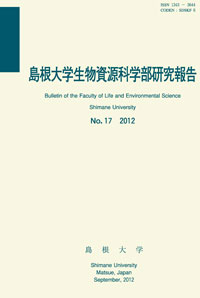島根大学生物資源科学部
ISSN:2435-0885(online)
ISSN:1343-3644(in print)
A publication of this bulletin in print format has not been made since no 24.
ISSN:1343-3644(in print)
A publication of this bulletin in print format has not been made since no 24.

number of downloads : ?
Use this link to cite this item : https://ir.lib.shimane-u.ac.jp/5110
Bulletin of the Faculty of Life and Environmental Science Shimane University 8
2003-12-20 発行
両生類における肝臓の比較組織化学的研究 : 肝臓の組織学的構築と棲息域および系統発生学的相関
Comparative histochemical studies of the liver in Amphibians associated with their phylogeny and diverged mode of living
Inoue, Asuka
File
Description
Background/aims: Amphibians are usually regarded as an intermediate group falling between fishes and reptiles, and have three orders: Gymnophiona, Urodela and Anura. They are widely distributed both geographically and ecologically. Their habitat ranges from water to land, and vertically from apical areas in trees to bottom layers in water. We studied on the correlationbetween the liver structures in the three orders of amphibians and their phylogeny or diverged mode of living. Methods: Forty-four species amphibians were collected from Hokkaidou to Iriomote island in Okinawa except Typhlonectes sp., Bombina orientalis and Xenopus leavis. Livers were fixed by perfusion with paraformaldehyde, cut paraffin sections, and observed by light microscope. The cytoskeletal components of the hepatic stellate cells were identified by immunohistochemistry for glial fibrillary acidic protein and α-smooth muscle actin. Results: Among the three orders of amphibians, Gymnophiona and Urodela were characterized both the pigmentation in hepatic lobules and the development of lymph vessels in liver capsules and Glisson's sheath. Conclusions: The present study indicates that there are differences in the pattern of hepatic histochemical components in the amphibians examined at this time. We discussed their phylogeny and diverged mode of living into three orders.
About This Article
Other Article
PP. 23 - 27
PP. 29 - 38
